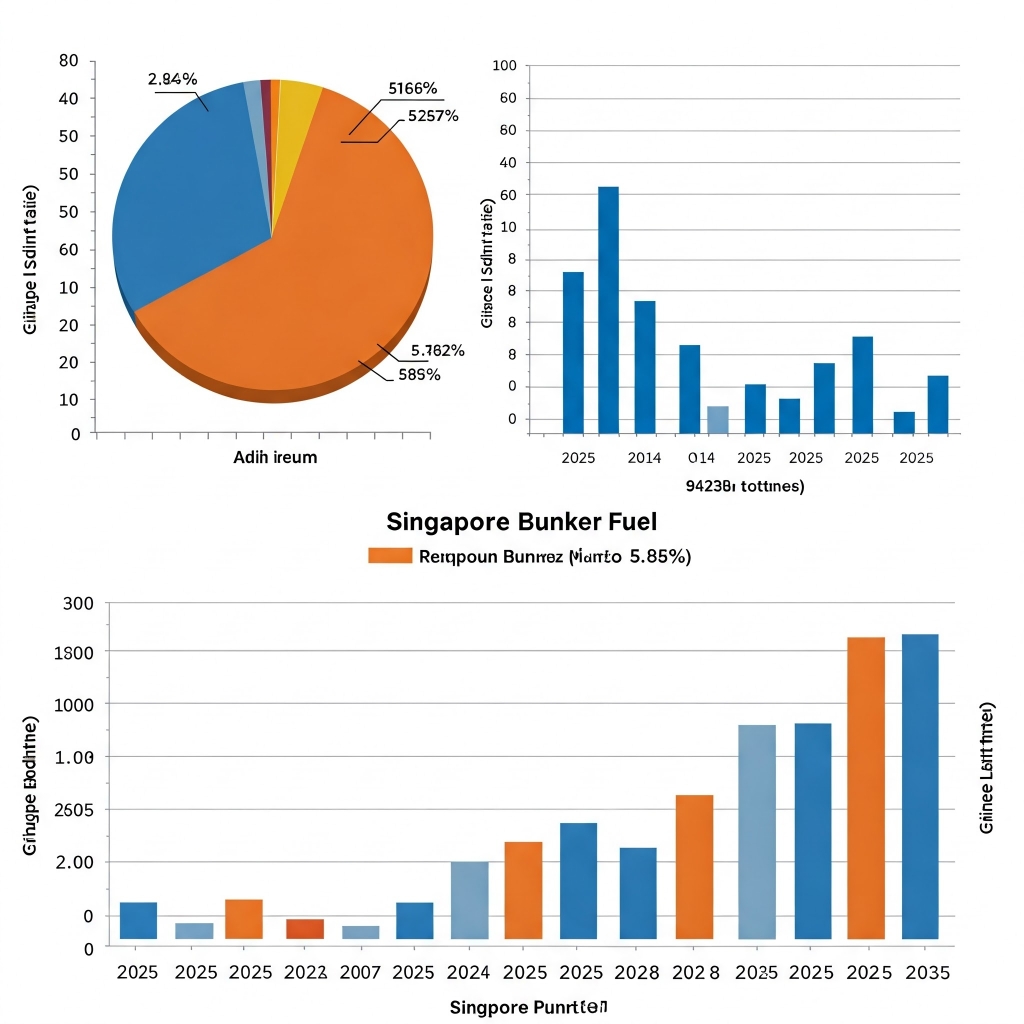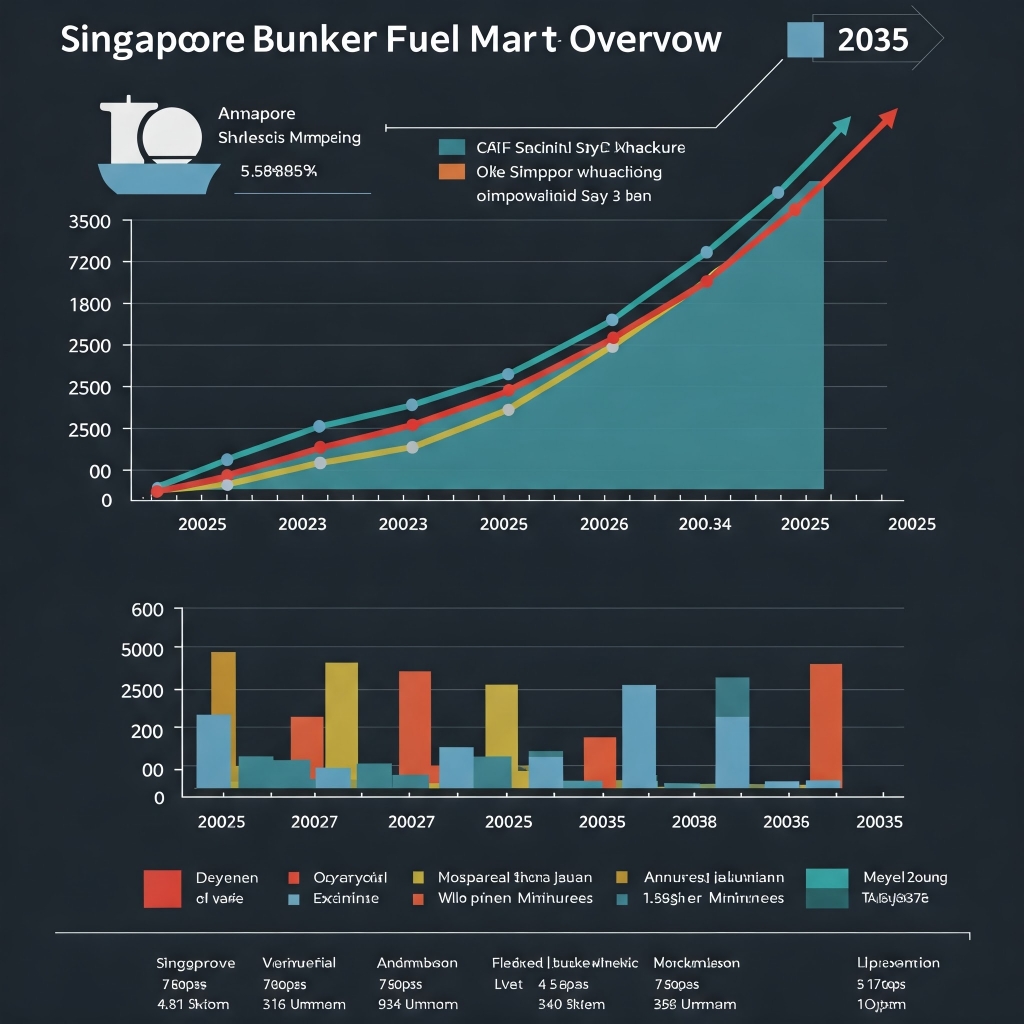Rewritten Report Content
Singapore Bunker Fuel Market Overview
The Singapore bunker fuel market was valued at 58.23 million tonnes in 2025 and is projected to reach 94.23 million tonnes by 2035, expanding at a CAGR of 5.85% during the forecast period from 2025 to 2035.
Singapore remains the world’s leading bunkering hub, strategically positioned along major global trade routes. With a robust marine infrastructure and efficient fuel delivery systems, the market serves a wide variety of vessels—from cargo ships and tankers to cruise liners and naval fleets.

Download Sample Ask for Discount Request Customization
Singapore Bunker Fuel Market Growth Drivers
Strategic Geographical Advantage and Rising Global Trade
Singapore’s prime location between the Pacific and Indian Oceans continues to drive its dominance in the global marine fuel market. Nearly 40% of the world’s bunkering demand passes through its ports. The rise in international shipping, particularly from major economies like China, India, and Japan, contributes significantly to the country's bunker fuel volumes. Additionally, expanding Southeast Asian manufacturing and surging container traffic support the growing need for efficient marine refueling services in the region.
Acceleration in LNG and Alternative Fuel Adoption
The global shift toward cleaner energy is rapidly reshaping Singapore’s bunkering landscape. Liquefied Natural Gas (LNG) has emerged as a popular low-emission marine fuel, supported by Singapore’s advanced LNG refueling infrastructure. The Maritime and Port Authority (MPA) has actively licensed LNG bunker suppliers and established dedicated LNG bunker vessels and terminals. Meanwhile, biofuels, methanol, and hydrogen are gaining traction as viable alternatives, driven by sustainability targets and fuel innovation by companies such as TotalEnergies and BP.
Digital Bunkering and Automation Advancements
Singapore leads in digital transformation within the marine fuel sector. Mass Flow Metering (MFM) has become the norm, ensuring precise and tamper-proof fuel measurements. Blockchain is also being used to secure transactions and reduce contractual disputes. Technologies powered by AI and machine learning are enhancing predictive analytics for fuel demand, optimizing voyage planning, and improving operational efficiency. Automation in fuel blending and cloud-based emission tracking tools are shaping a smarter and more sustainable bunker fuel ecosystem.
Singapore Bunker Fuel Market Challenges
Crude Oil Price Volatility and Cost Impacts
Fluctuations in global crude oil prices have a direct impact on bunker fuel costs. Geopolitical instability, OPEC+ production decisions, and macroeconomic uncertainties—such as the aftermath of COVID-19 and ongoing regional conflicts—continue to drive price unpredictability. These price swings affect ship operators’ fuel budgeting, pushing them towards long-term hedging contracts and more flexible pricing models.
Singapore Bunker Fuel Market Trends
Expansion of Low-Carbon Fuel Infrastructure
Singapore is ramping up its capabilities to meet International Maritime Organization (IMO) emissions goals. The city-state has invested heavily in LNG refueling facilities and biofuel blending projects. Methanol and hydrogen supply chains are also evolving, supported by public-private partnerships and long-term green shipping initiatives. This strategic direction cements Singapore’s position as a global front-runner in sustainable bunkering practices.
Singapore Bunker Fuel Market Segmentation
By Fuel Type
-
Low Sulfur Fuel Oil (LSFO)
-
High Sulfur Fuel Oil (HSFO)
-
Marine Gas Oil (MGO)
-
Others (including LNG, Methanol, Biofuels)
LSFO continues to dominate due to compliance with IMO 2020 regulations, which mandate sulfur content below 0.5%. While HSFO remains in use among vessels fitted with scrubbers, the bulk of demand has shifted to LSFO owing to its compatibility with existing engines and lower retrofit costs. LNG and biofuels are emerging segments, increasingly adopted as part of broader decarbonization strategies.
Download Sample Ask for Discount Request Customization
Singapore Bunker Fuel Market – Report Scope
|
Parameter
|
Details
|
|
Study Period
|
2020–2035
|
|
Base Year
|
2024
|
|
Forecast Period
|
2025–2035
|
|
Market Size (2025)
|
58.23 Million Tonnes
|
|
Market Size (2035)
|
94.23 Million Tonnes
|
|
CAGR (2025–2035)
|
5.85%
|
|
Market Segmentation
|
- By Fuel Type
- By Vessel Type
- By Bunkering Method
|
|
By Fuel Type
|
- High Sulfur Fuel Oil (HSFO)
- Low Sulfur Fuel Oil (LSFO)
- Marine Gas Oil (MGO)
- Others (LNG, Biofuels, Methanol)
|
|
By Vessel Type
|
- Container Ships
- Tankers
- Bulk Carriers
- Cruise Ships
- Offshore Vessels
|
|
By Bunkering Method
|
- Ship-to-Ship Transfer
- Port Bunkering
- Truck-to-Ship
|
|
Key Players
|
- BP Marine
- ExxonMobil Marine
- Shell Eastern Trading
- TotalEnergies Marine Fuels
- Chevron Marine Lubricants
- Sinopec Fuel Oil
- Bunker One
- PetroChina International (Singapore)
|
|
Geographic Coverage
|
Singapore
|
|
Key Trends
|
- Adoption of LNG and biofuels
- Smart bunkering systems
- Digital fuel transaction platforms
|
|
Report Deliverables
|
- Market Size & Forecast
- Market Trends & Dynamics
- Competitive Landscape
- Segmental Analysis
|

Download Sample Ask for Discount Request Customization
Key Players in the Singapore Bunker Fuel Market
-
TotalEnergies Marine Fuels
-
BP Marine
-
ExxonMobil Marine Fuels
-
Shell Eastern Trading
-
Chevron Singapore Pte Ltd
-
PetroChina International (Singapore)
-
Vitol Bunkers Pte Ltd
-
Equatorial Marine Fuel Management Services Pte Ltd
-
Global Energy Trading Pte Ltd
-
Minerva Bunkering Pte Ltd
Singapore Bunker Fuel Market Recent Developments
In August 2024, TotalEnergies Marine Fuels completed its first full-scale B100 biofuel bunkering operation in Singapore. A large ocean-going vessel was supplied with 1,032,000 gallons of renewable-sourced biofuel, reflecting the country’s strong push toward sustainable energy alternatives.
Singapore Bunker Fuel Market Segmentation
By Fuel Type
-
Low Sulfur Fuel Oil (LSFO) – Dominant segment due to IMO 2020 sulfur regulations
-
High Sulfur Fuel Oil (HSFO) – Used by ships with scrubbers
-
Marine Gas Oil (MGO)
-
Others – LNG, Methanol, Biofuels, Hydrogen
By Vessel Type
By End-User
By Bunkering Method


